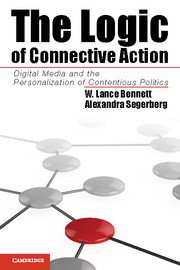Book contents
- Frontmatter
- Contents
- List of Tables and Figures
- Acknowledgments
- Introduction
- 1 The Logic of Connective Action
- 2 Personalized Communication in Protest Networks
- 3 Digital Media and the Organization of Connective Action
- 4 How Organizationally Enabled Networks Engage Publics
- 5 Networks, Power, and Political Outcomes
- 6 Conclusion
- Bibliography
- Index
6 - Conclusion
When Logics Collide
Published online by Cambridge University Press: 05 June 2014
- Frontmatter
- Contents
- List of Tables and Figures
- Acknowledgments
- Introduction
- 1 The Logic of Connective Action
- 2 Personalized Communication in Protest Networks
- 3 Digital Media and the Organization of Connective Action
- 4 How Organizationally Enabled Networks Engage Publics
- 5 Networks, Power, and Political Outcomes
- 6 Conclusion
- Bibliography
- Index
Summary
Recent years have witnessed large-scale protests in a multitude of national and transnational contexts, from long-running actions focused on economic justice and climate change politics to large-scale political uprisings in Iceland, the Middle East, Europe, and North America. Reactions to the sudden waves of protest that brought massive crowds into public squares, streets, and parks framed the discussion in stark and polarizing terms. Some observers implied that social media caused these political upheavals or that they erupted spontaneously; others insisted that technology was as good as irrelevant in these contexts. Some commentators concentrated on the lack of correspondence between the crowd protests and the type of contentious action based on conventional movements that has predominated in modern democracies; others overlooked the fact that many NGOs have altered their network structures to accommodate more inclusive and personally engaging media affordances. In all, many observers of these flexible, multi-issue networks seemed to miss or misconstrue several key factors, including the roles and organizational properties of digital media and the increasingly personalized nature of shared political action.
This book offers a framework for distinguishing the roles of digital media in different types of large-scale collective action. Our aim was to explore how digitally networked action works: how it is organized, what sustains it, and what political capacity it can have. The point was not to replace existing perspectives, but to show what their scope and boundaries are and to illuminate how different kinds of action networks have different signatures that characterize their engagement of publics, their organization, and their acquisition and utilization of political power.
- Type
- Chapter
- Information
- The Logic of Connective ActionDigital Media and the Personalization of Contentious Politics, pp. 194 - 216Publisher: Cambridge University PressPrint publication year: 2013

